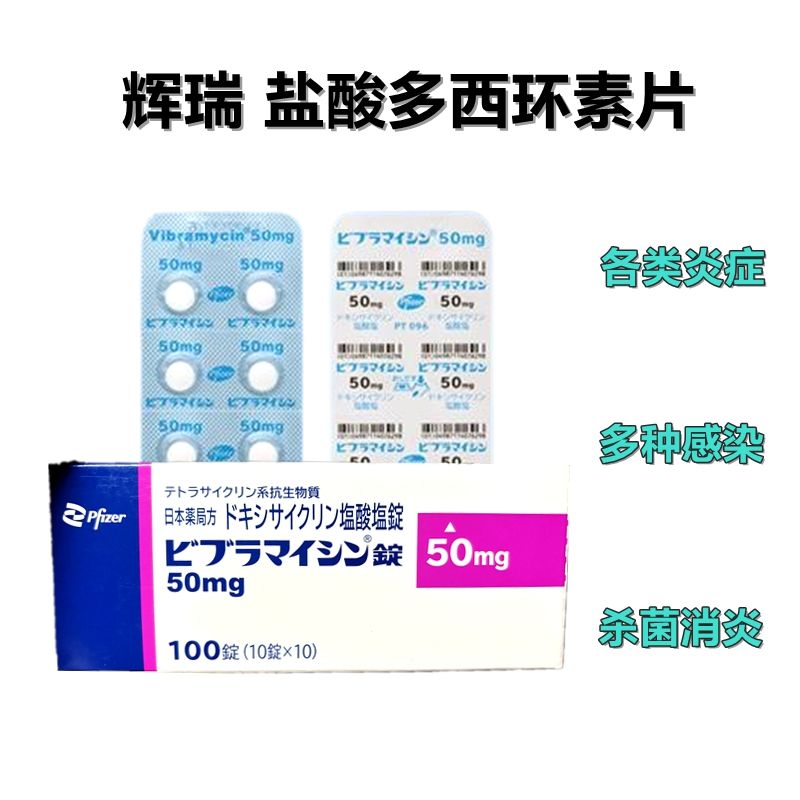
Among the wide world of antibiotics, there is one that stands out for its broad-spectrum efficacy, diverse uses, and minimal side effects—Doxycycline.
Whether it’s for travelers, mycoplasma pneumonia, acne treatment, or malaria prevention, Doxycycline is a go-to medication increasingly recognized by both physicians and patients.
Today, let’s dive deep into the Doxycycline manufactured by Pfizer Japan Inc., exploring its pharmacology, clinical uses, formulation, and precautions—your ultimate guide to this powerful, under-the-radar antibiotic.
? 1. What Is Doxycycline?
Doxycycline is a semi-synthetic tetracycline-class antibiotic, a second-generation derivative that features structural modifications offering several advantages:
? Higher Lipid Solubility: Enhances gastrointestinal absorption and bioavailability
? Longer Half-Life: Once or twice daily dosing improves convenience
? Lower Resistance: Effective against some tetracycline-resistant strains
? Anti-Inflammatory Properties: Useful for dermatological inflammatory conditions
? Mechanism of Action:
Doxycycline binds to the 30S subunit of bacterial ribosomes, inhibiting protein synthesis and thereby preventing bacterial proliferation (a bacteriostatic effect).
? 2. What Makes Pfizer Japan’s Doxycycline Stand Out?
Pfizer is a globally renowned pharmaceutical giant. Its Japanese subsidiary, Pfizer Japan Inc., is known for producing high-quality prescription medications adhering to stringent local and international standards.
? 1. Superior Manufacturing Standards
✅ Compliant with the Japanese Pharmacopoeia (JP) and global GMP standards
✅ High chemical purity, with tight control over impurities
✅ Each batch is registered and reviewed by Japan’s Ministry of Health, Labour and Welfare
? 2. Accurate Dosage & Practical Packaging
? Commonly available in 50mg capsules or tablets (capsules more widely used)
? Comes in moisture-proof aluminum blister packs—convenient for travel and storage
? 3. High Efficacy, Minimal Side Effects
✔️ Absorption rate exceeds 90%
✔️ Effective against Mycoplasma pneumoniae, Chlamydia, Vibrio cholerae, and Plasmodium spp.
✔️ Gentler on the stomach compared to traditional tetracyclines
? 3. Broad Clinical Applications—Beyond Just Coughs and Colds
? 1. Respiratory Infections
Mycoplasma pneumonia: Particularly effective in teenagers and young adults
Chlamydia pneumoniae, Legionella pneumophila: Works well on atypical pathogens
? 2. Sexually Transmitted Infections
A first-line treatment for non-gonococcal urethritis and cervicitis
Can be part of combination therapy for gonorrhea and syphilis
? 3. Malaria & Tropical Disease Prophylaxis
Often recommended for travelers visiting Southeast Asia or Africa
Taken once daily to prevent malaria, with good tolerability
? 4. Dermatological Use
Treats moderate to severe inflammatory acne (papules, pustules)
Useful for rosacea and perioral dermatitis due to anti-inflammatory effects
Low-dose long-term regimens (e.g., 50mg/day) effectively control symptoms
? 5. Zoonotic & Rare Infections
Used for Rickettsial diseases (e.g., typhus, Q fever)
Also indicated for Lyme disease, cholera, plague
Endorsed by the CDC for treatment or prevention of anthrax, brucellosis, plague, and more
? 4. Dosage Guidelines (For Reference Only)
Indication Dosage Duration
General adult infections 200mg loading dose, then 100mg once or twice daily 7–14 days
Mycoplasma pneumonia 100mg twice daily Typically 7–14 days
Acne treatment 50–100mg once daily Minimum 8–12 weeks
Malaria prophylaxis 100mg daily Start 1 day before travel and continue 4 weeks after return
⚠️ Note: Always follow a doctor’s prescription. Special care should be taken with children, pregnant women, and patients with liver or kidney disorders.
⚠️ 5. Important Usage Precautions
Though generally well-tolerated, users should still be mindful of the following:
? 1. Take with food to avoid GI upset
Taking it on an empty stomach can cause nausea or diarrhea
It’s fine to take with non-dairy food (avoid high-calcium meals)
? 2. Avoid combining with calcium, iron, magnesium, or aluminum
These ions can form chelates with Doxycycline, reducing absorption
Keep at least a 2-hour interval before/after such supplements
? 3. Photosensitivity Warning
Avoid direct sun exposure while taking the drug
Use sunscreen, hats, or umbrellas when going outdoors
? 4. Avoid long-term high-dose use
May cause liver or kidney issues, and increase risk of antibiotic resistance
Long-term acne treatment patients should have liver function tests every 3 months
? 6. Who Should Consider Keeping Doxycycline Handy?
Doxycycline is more than just an “antibiotic for colds.” It’s a reliable choice in many specialized cases and worth including in your household medicine kit if you are:
✈️ A frequent traveler to tropical or developing regions
?⚕️ Prone to mycoplasma infections or recurrent UTIs/STIs
? Dealing with persistent acne or rosacea requiring long-term care
When taken under medical supervision, Doxycycline from Pfizer Japan is a trustworthy, high-quality option to keep you protected in a variety of situations.
? Have you ever used Doxycycline? How was your experience? Leave a comment and share with others!
? Follow us for more medical insights and trusted product reviews from around the world!
